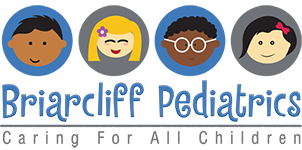Staph Infections: How Worried Should You Be?
- On Jan, 22, 2019
- Doctor Notes
- Latest News
At Briarcliff Pediatrics, we consider our ability to help kids stay healthy and give parents some peace-of-mind a great privilege. Lately, we’ve spoken to several parents with concerns over staph infections and methicillin-resistant Staphylococcus aureus (MRSA). We understand that this condition can be scary for parents to read about, but it’s important to make sure you’re doing what you can to keep yourself and your child from having serious staph-related health problems. Therefore, we’re bringing you some tips on avoiding staph infections and symptoms to look out for in this week’s blog:
 The bacteria that cause staph infections (staphylococcus) are commonly found on the skin or in the nose. Even healthy people often carry these bacteria, experiencing no related issues most of the time (or only minor infections). However, if the staphylococcus bacteria manage to enter a person’s bloodstream, lungs, heart, joints, or bones, a staph infection can become a serious concern. These bacteria can enter the body through a break in the skin, or they can enter with the food your child eats.
The bacteria that cause staph infections (staphylococcus) are commonly found on the skin or in the nose. Even healthy people often carry these bacteria, experiencing no related issues most of the time (or only minor infections). However, if the staphylococcus bacteria manage to enter a person’s bloodstream, lungs, heart, joints, or bones, a staph infection can become a serious concern. These bacteria can enter the body through a break in the skin, or they can enter with the food your child eats.
Staph infections can bring on a few different symptoms. The severity of a staph infection can vary widely, so symptoms may as well. The most common symptom is the presence of boils on the skin. These pus-filled boils form in a hair follicle or oil gland and make the skin around them appear red and swollen. Although the boils associated with a staph infection can show up virtually anywhere on the body, they’re most commonly found under the arms, around the buttocks, or in the groin area. All staph infections of the skin may include blisters and/or ulcers that often ooze fluid, as well as a fever. Other staph-related symptoms of the skin include:
- Impetigo – a contagious rash, usually accompanied by large blisters
- Cellulitis – a deep skin infection that causes swelling and redness on the skin’s surface
- Staphylococcal scalded skin syndrome – a condition that causes fever & rash and most often affects children and babies. The blisters that sometimes accompany staphylococcal scalded skin syndrome are distinctive in that, when they break, the top layer of skin comes off, revealing a surface that looks like burned skin (thus the name).
Staphylococcus bacteria can also be ingested and are among the most common causes of food poisoning. The potential apparent symptoms initially include nausea, vomiting, dehydration, diarrhea, and low blood pressure. There’s usually no fever involved with staph when it’s contracted through food. Symptoms manifest within hours of ingesting the contaminated food, and they typically disappear quickly as well. It’s important to seek medical treatment for your child as soon as possible if you think they have a staph infection. The bacteria can travel deeper into one’s body, causing critical infections of the brain, lungs, heart, bones, and/or muscles. Furthermore, staph infections can lead to conditions like toxic shock syndrome and septic arthritis.
Two simple hygienic rules can help you and your child avoid staph infections:
- Wash your hands regularly with soap and water;
- Avoid sharing soap, towels, and other personal items with other people. If you or your child must share sports or gym equipment, make sure it’s clean.
Staph infections are contagious, so if your child gets one:
- Make sure your child avoids physical contact with other people;
- Ensure they wash their hands frequently;
- Wash their clothes in hot water and dry them in a hot dryer;
- Make sure they do not share towels, clothes, linens, etc. with other people;
- Keep the infected area dressed with a clean bandage.
Though the abscesses (sores, blisters, and boils) that accompany a staph infection must be drained of their fluid for the infection to heal, do not attempt to pop or puncture any abscesses yourself. Apply a warm compress and allow it to drain naturally. If it’s not draining on its own, your pediatrician can safely induce draining.
Finally, you should seek medical attention for your child (or yourself) if:
- Your child gets a new fever or their fever lasts more than one day;
- They have severe pain, weakness, difficulty breathing, headache, or new cough;
- Their infected area seems to be spreading or increasing in redness or pain.
Staph infections can be serious, but as long as you follow these guidelines and remember what to look out for, there’s no reason to be anxious or fearful. Dr. Ray Deeb and Dr. Ashley Brown provide comprehensive healthcare for newborns and children up to the age of 18, and they’re currently accepting new patients. If you would like to learn more about our practice, contact Briarcliff Pediatrics to schedule an appointment or a complimentary meet-and-greet. Don’t forget to follow us on Facebook and Instagram to get the latest health tips and news in children’s healthcare, and check back often for new blogs.




